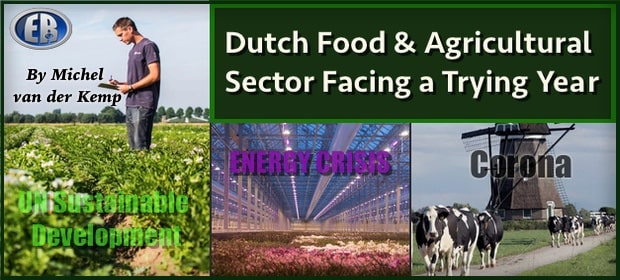
ER Editor: Dutch journalist Michel van der Kemp examines the current vulnerabilities of The Netherlands’ food-producing sector given a thoroughly diverse number of factors that are putting supply chains, trade practices and energy prices at risk around the globe. The picture for 2022 isn’t a clear one yet because so many of these factors are changing and developing.
What is clear to us at ER, however, is that many of these crises are entirely manufactured (the Corona nonsense, UN Sustainable Development policies/EU interpretation of them, the energy ‘crisis’, etc.), which makes the fuller picture a little sinister in our opinion. As we’ve covered at ER over time, the elites do not want us to have cheap energy and quality food independence. On the contrary. The UN Agenda 21 policy does not favour farmers. What better than to have a storm of ‘crises’ all impacting this sector of the economy all at once …
The Netherlands, the world’s second biggest exporter of food stuffs, is a key country for the EU as well as for itself. Here’s what is happening.
********
Dutch Food Production Could Face Its Most Difficult Year Yet
MICHEL VAN DER KEMP
In this article, we take a look at the current vulnerability of European food chains, specifically through the lens of Dutch agrarian export products, which Europe relies on.
The Netherlands is the second largest exporter of agrarian products in the world (the USA is number one). The export value of the Dutch agrarian sector in 2021 totalled 104.7 billion euros, crossing the 100 billion mark for the first time in history.(1) Sixty-nine percent (69%) of Dutch exports stay within the EU. The Dutch are particularly vulnerable because of the large-scale use of greenhouses, which critically depend on energy prices. The EU, in turn, becomes vulnerable because if Dutch exports collapse, the whole of Europe will feel the effects, both direct and indirect. The agrarian sector of the Dutch economy is thus very much a European affair.
Current energy prices risk putting 35-45% of greenhouse farmers out of business, but this is just one of FOUR artificial events that are starting to line up, which could create a disaster for Dutch exports in 2022 and, as a result, for the European food chain itself. These events are:
- Corona pandemic
- Brexit
- New international policies that are part of the UN Sustainable Development Goals
- The Ukrainian ‘crisis’ (war plus economic sanctions), whose biggest effect may be an energy crisis
After looking at each event, we’ll take a quick look at the major export partners of The Netherlands.
Corona
During 2020 and 2021, trade in agrarian products was relatively less influenced by the corona crisis. That’s because there is a limited sensitivity to the crisis due to the inherent necessity for food. The result of the virus, however, is still that worldwide food chains have been disrupted and a lot of prices have gone up. Dutch export levels of fruit have been stable while the export of floriculture, meat, dairy, eggs and vegetables throughout 2020 was tougher: Twenty-nine percent of agricultural companies received corona subsidies. The corona pandemic has especially disrupted container trade to non-EU-countries. The mismatch between a strong growing demand after the first recovery of the pandemic and the decreased supply capacity has led to record prices.(2)
And all evidence shows corona is not over. China has gone into a new lockdown for many millions of its citizens, Anthony Fauci has warned of more lockdowns, while the WHO is anxious about the rise in cases in Europe. Policies like lockdowns have not been abolished, contrary to what we might believe: they have merely been suspended, and in some countries, they are still in effect or being reimplemented. The completely unscientific handling of the pandemic in 2020 and 2021 by governments makes a prediction for 2022 impossible.
Brexit
The UK formally left the EU on January 31, 2020, but a transition period followed in which the UK stuck to the EU trade rules.
In the period 2015-2021, agrarian trade with the UK showed a clear contraction. The year 2015 served as a reference for the pre-Brexit period. This goes for import, re-export, and export of Dutch-produced goods. The year 2021 is responsible for the import and re-export contraction. Export to the UK showed a small growth, compared to 2020. British customs are only going to enforce specific phytosanitary and veterinary monitoring of agrarian products, as well as administrative obligations starting in 2022, which is due to the Trade and Cooperation Agreement (TCA) between the EU and UK.
On top of that, new tariffs were introduced starting January 1, 2021 for products that cannot be proven to be produced in the EU or the UK (British re-export). Finally, there can be another future Brexit-effect. One of the motivations for the British to leave the EU was so they could make their own rules, which includes rules in relation to international trade.(3) For these reasons, the full effects of Brexit on Dutch export will become noticeable in 2022.
International policies
Under the umbrella of the UN Sustainable Development Goals, the European Commission came in February 2022 with guidelines on sustainable corporate governance. On the basis of these guidelines, companies in the EU are forced to observe “due diligence in their supply chains”. These guidelines deal with social themes (like child labour, work environment, slavery) and environmental themes (like climate and biodiversity). The guidelines are currently still in the proposal phase, so it’s not yet clear what they mean in practice.
The effects of these kind of policy changes may be hard felt in the agrarian sector, however, where the margins for profit-making are extremely narrow. Any policy change in the agrarian sector is therefore likely to show an immediate effect on consumer prices.
The European Commission has also decided that in 2023, for 4% of land assigned for agrarian purposes, nothing may be grown. To achieve this in the fall of 2022, farmers may no longer sow the land assigned marked for reduction. [ER Editor: See this article we put out on the Dutch confiscation of farmland. The Dutch govt. is hiding behind nitrogen regulations. But it’s just an excuse to meet the European demands.]
Ukrainian crisis
Since the Ukrainian crisis is a very recent one and events are still unfolding, it is difficult to paint a precise picture of the immediate future. But we will look back first and see what the import profile from Ukraine, Russia, and Belarus looked like before the military conflict.
For Ukraine, the EU – with a total export value of 5.4 billion euros in 2020 – is the most important trading partner. The most important trade group for Ukrainian export is grains (42%). In addition, animal and plant oils have an export value totalling 25.9%. Two other important export products are oilseeds and cattle (8 and 7%). The export value of Russia to the EU in 2020 was 2.7 billion. Divided into the product groups, we have 33% grains, 16% fish, and 14% animal and plant oils. For Belarus, only Poland and Norway are in the top-10 of export countries, but with a total export value of 5 billion euros, only about 1% goes to Poland and Norway. The most important product groups are dairy and eggs, meat, and meat and fish products.
For a number of trade groups, import from Ukraine is significant (oils, and grains). For The Netherlands, Russia has a total import value of 24.1 billion euros. But 23.5 billion euros are for non-agrarian products (energy). The Netherlands imports 458 million euros in agrarian products (fish, and fertiliser). Import value from Belarus is 62 million in 2021 for agrarian products.
There are signals that through the Ukrainian crisis, the availability of biological animal feed will put pressure on the whole chain for biological animal products. Biological products are a strong growing market in the whole EU. The crisis also has possible effects for the availability of workforce in the agrarian sector, and agrarian logistics.(4)
Now that the trade picture is complete, we can see that the import value into the EU, and The Netherlands is limited. There are a few areas that are problematic (oils, grains, biological animal feed and fertiliser), and a total embargo on trade with Ukraine, Russia, and Belarus would have have a cascading effect.
The bigger problem we see, and has been reported upon, is energy.
Energy
According to numbers on the EU website, Russia is the main supplier of crude oil, natural gas and solid fossil fuels. Crude oil from Russia makes up 26.9% of the total import of crude oil; Natural gas from Russia makes up 41.1%; Solid fuel 46.7%.
Why is this important for the agrarian sector, and the Dutch agrarian sector in particular?
Despite being a small, highly populated country, the Dutch achieve their status of second biggest exporter mainly due to the use of greenhouses. Greenhouses are not just glass structures in which crops are grown. Inside, high-tech computers monitor the light, temperature, water levels and minerals that crops need to grow optimally. At exactly the right time, computers give plants what they need. This makes it possible to have high yields in a dense area. The downside of growing food in greenhouses, however, is that it requires a lot of energy. Under normal circumstances between 20 and 30 percent of the price of a tomato and cucumber is made up by the cost of energy, and the price of transportation is not included in that.
According to Adri Bom-Leenstra, chair of the Greenhouse Farmers Netherlands (Glastuinbouw Nederland GNL), gas prices have risen tremendously since 2021. Farmers used to pay between 7 and 20 eurocents per cubic meter, but the price increased to around 180 eurocents during Christmas 2021. Bom-Lenstra says “gas prices threaten to bring down this entire top sector.” Between 35 and 45% of greenhouse farmers are under immediate threat of closure, either forever or temporarily. The crisis is affecting the whole sector, whether one farms cucumbers or roses.
The main problem is not the price of energy itself, but the contracts farmers have. On the one hand, they have contracts with their gas suppliers, and on the other, they have delivery contracts with buyers. If one or the other cannot be broken, the farmers go out of business. Farmers who do not have legally binding contracts can calculate the production costs into the end price. Of course, then consumers will start paying much higher prices.
The Ukrainian crisis, mainly the economic sanctions, will further escalate the rise of energy prices. It will definitely not reduce the incredible danger that is creeping up on our food chains. Everything seems to be lined up for one hand coming out of the shadow to tip over the first domino.
Finally, let’s look at the major export partners of The Netherlands so we get a better grasp of which countries will be most effected by Dutch production and export problems.
Export partners
Most of the agrarian export in 2021 went to Dutch neighbours. A quarter went to Germany (26.3 billion euros). In second place there is Belgium (12.1 billion euros). After that followed France and the UK (both 8.6 billion euros). These 4 countries account for a total of 53% of total Dutch farm exports.
Exports to China (in fifth place) had especially grown in the period 2015-2020. The period showed a growth of 150% (from 0.75 billion euros in 2015 to almost 1.9 billion euros in 2020). This strong growth is especially due to the export of baby milk powder and pork. In 2021, the export saw a small decrease of 35 million euros.
The EU – in which we no longer include the UK – is by far the biggest export partner, totalling 69%.(5)
****
NOTES
1 De Nederlandse agrarische sector in internationaal verband – editie 2022. https://www.cbs.nl/- /media/_pdf/2022/03/de-nederlandse-agrarische-sector-2022.pdf(p. 20)
2 De Nederlandse agrarische sector in internationaal verband – editie 2022. https://www.cbs.nl/- /media/_pdf/2022/03/de-nederlandse-agrarische-sector-2022.pdf (p. 69-73)
3 De Nederlandse agrarische sector in internationaal verband – editie 2022. https://www.cbs.nl/- /media/_pdf/2022/03/de-nederlandse-agrarische-sector-2022.pdf (p. 60-67)
4 Impactanalyse oorlog in Oekraïne. Eerste versie 10 maart 2022. https://www.rijksoverheid.nl/binaries/rijksoverheid/documenten/rapporten/2022/03/10/impactanalyse-oorlog-inoekraine/impactanalyse-oorlog-in-oekraine.pdf
5 De Nederlandse agrarische sector in internationaal verband – editie 2022. https://www.cbs.nl/- /media/_pdf/2022/03/de-nederlandse-agrarische-sector-2022.pdf (p. 20-24)
***********

••••
The Liberty Beacon Project is now expanding at a near exponential rate, and for this we are grateful and excited! But we must also be practical. For 7 years we have not asked for any donations, and have built this project with our own funds as we grew. We are now experiencing ever increasing growing pains due to the large number of websites and projects we represent. So we have just installed donation buttons on our websites and ask that you consider this when you visit them. Nothing is too small. We thank you for all your support and your considerations … (TLB)
••••
Comment Policy: As a privately owned web site, we reserve the right to remove comments that contain spam, advertising, vulgarity, threats of violence, racism, or personal/abusive attacks on other users. This also applies to trolling, the use of more than one alias, or just intentional mischief. Enforcement of this policy is at the discretion of this websites administrators. Repeat offenders may be blocked or permanently banned without prior warning.
••••
Disclaimer: TLB websites contain copyrighted material the use of which has not always been specifically authorized by the copyright owner. We are making such material available to our readers under the provisions of “fair use” in an effort to advance a better understanding of political, health, economic and social issues. The material on this site is distributed without profit to those who have expressed a prior interest in receiving it for research and educational purposes. If you wish to use copyrighted material for purposes other than “fair use” you must request permission from the copyright owner.
••••
Disclaimer: The information and opinions shared are for informational purposes only including, but not limited to, text, graphics, images and other material are not intended as medical advice or instruction. Nothing mentioned is intended to be a substitute for professional medical advice, diagnosis or treatment.




